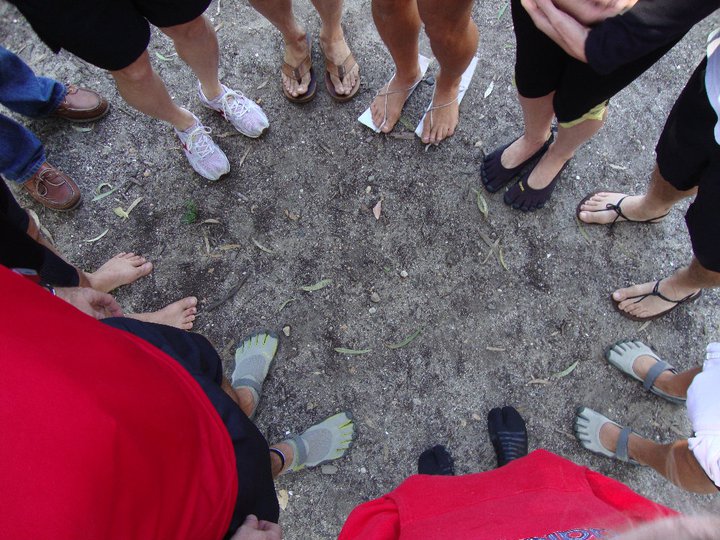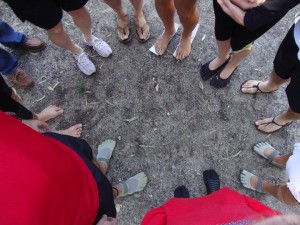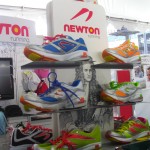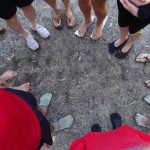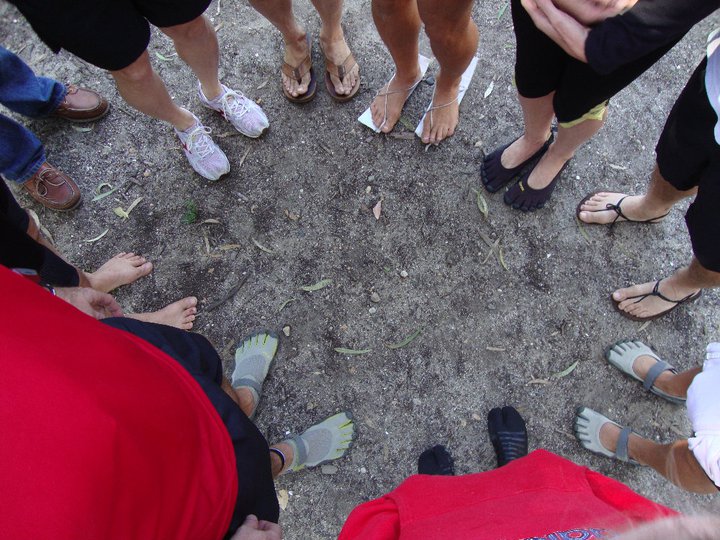Actually, I mean “More on” barefoot shoes… but I thought “moron” an apt homonym. Then again maybe I really do mean, “moron”… But, don’t take offense at being called moron. It’s just a play on words and has no more integrity here than the term “barefoot shoes”…
Summary
This is a response to Jason Robillard’s post on trying to reach the masses by accepting that the term “barefoot shoes” is popular (I do accept that it is popular) and using the term so as to make our message more acceptable to the masses.
This message has been edited, expanded, and refined since being posted on Jason’s website, and no doubt it will undergo a bit more editing and refining in the future (much like barefoot running technique works because of the concept of continuous improvement, through continuous feedback, from our bare soles).
Watering down the message by accepting the term “Barefoot Shoes”
So, you’re saying I should start wearing minimalist… I mean “barefoot” shoes, despite that for the past 50 years, I have never actually needed any foot protection (other than for social acceptance or to conform with rules and regulations)… Conform or be shunned by the current crop of barefoot running “educators”. I’ve never been good at conformity, so I’ll stick with what I am good at, being me, and hopefully continually improving that.
I will admit that there is a place for footwear, if you’re interested in running to extremes, like ultra-marathons, or dozens of miles on rough gravel trails, or in freezing cold, etc. for example, had I decided to run the 100 mile Born to Run Ultra Marathon, instead of just the 10 mile event which I ran barefoot (not in “barefoot shoes”), I might have wanted some sort of protection for my soles… but then the rest of my body wasn’t ready for that anyway, and I even told people on that course that I understood why only one person (not me) actually ran more than the single 10 mile loop literally barefoot (in fact I was impressed that one person actually managed it, and he wasn’t even an experienced barefoot runner – until after completing the 50K event on that gravelly course)… And while there was one person running the 50K, Micha True’s dog ran more than 20 miles on that gravelly course, barefoot!
While minimalist footwear may be useful for those who want to run dozens of miles over gravel trails, or other extreme conditions, these are not the kinds of things to be concerned about when you first learn how to run, or re-learn how to run gently. “Barefoot shoes” are not the answer for those who want to start running barefoot. Nor are they necessary for those of us who don’t plan on running hundreds of miles a week. I’ve always managed to not only work gently through 10-15 mile stretches of rough terrain, but also to improve my running technique in the process.
Acceptance of Reason
You can fool all the people some of the time and some of the people all the time but you cannot fool all the people all the time… -Abraham Lincoln, or maybe, P. T. Barnum, or maybe, John Lydgate, or maybe, Mark Twain
Yes, me and my ideas might never be accepted as “normal”, but then we never were, except by a few reasonable people. Whenever I tried to conform I was only accepted by a few unreasonable people and only for as long as I could fool them (and I’ve never been much good at fooling people either). Fortunately for those who do try to conform, there are a lot of unreasonable people out there easy enough to fool, for a time, and if you’re better at fooling people than I am (one of the reasons I don’t work in marketing).
I on the other hand, have reassigned myself to a life of being myself and being accepted and respected by a select few reasonable people (who are not interested in trying to make me pretend to be someone other than myself), rather than trying to fool a few unreasonable people some of the time. Yes, I realize that I do think differently than most people – in philosophy classes only a small percentage of the class understood even the most simple logic, so it’s no surprise that most people don’t get my reasoning. That’s because it actually is based on reason, not on popularity, or commonly held misconceptions.
If a test doesn’t fail bad products, the test is of no value.
I had the same issue when I worked in quality assurance. The fellow who made some of the in-house test equipment figured it good enough if his testers confirmed that good product was good. He couldn’t understand that the purpose of a test wasn’t to just pass good products, but rather to tell us the painful news when we are manufacturing bad products.
And that’s actually a good analogy of why barefoot running helps people learn to run better, and “barefoot” shoes do not. It is possible to run well in “barefoot” shoes. Just like the test equipment above, if you have a good product, the tester would tell you the product was good. However, you could put a bad product in the tester and get the same answer, that it was good. The tester would pass almost anything, as long as it was at least 25% functional.
And that’s pretty much what any footwear that is protecting our soles from discomfort is doing. It is telling us that we are “running just fine… no need to change a thing!” That’s not the kind of coach you want teaching you how to improve your running technique!
The purpose of a test isn’t popularity
A good test actually will tell you when a product isn’t going to work. That may not be what you want to hear. That means you need to change, and if you don’t it will continue to hurt while you run barefoot, especially on stimulating terrain.
And that’s exactly why “barefoot” shoes are so popular. Unlike bare soles, the “barefoot” shoes will tell you that you’re doing “just fine” … no matter if you’re actually running safely or not. You only need improve your technique a little bit over what was comfortable in thickly padded shoes.
Your bare soles, on the other hand, will SCREAM at you, if you do anything that is stressful on the soles. They will scream at you emphatically! They will scream at you immediately! They will scream at you with each and every step! Until you change the way you’re running to eliminate the excess stresses and strains.
If the way you’re running puts too much strain on your bare soles, chances are you’re putting too much stress and strain on the rest of the body … at least in the long run (cumulative damage). It means you should be changing the way you are running. It means you are doing something wrong! And that’s not a popular message!
It means you should go back to the assembly line, and figure out how to make good product!
Well, the fellow who made the tester above didn’t like my message either, because I was honest. I told him that the tester he built didn’t actually test for bad parts. He didn’t get my logic either. He figured if it passed good parts, that was all that was required… He didn’t think we should even test the test equipment to see if it failed bad switches … after all that didn’t seem very “productive”.
My ideas about barefoot running (and many other things as well ) never were very popular until barefoot running began to become popular – but, again, they become popular, not because I compromised, but because I was honest, and because that honesty helped thousands of people learn to run better. And there are billions of people out there waiting for that same message.
Even if many people don’t get the logic about the importance of immediate feedback from the bare soles letting us know when we are running badly, they do get that it helps them run better, because it does help them run better, and ultimately to hurt less … unless we’re willing to water down the message by telling them, or implying, that they can get the same benefits by wearing “barefoot” shoes, starting out on comfortable terrains, like soft sand or grass. Those who try the watered down version, often end up with sore calves and later, sore feet. And if they continue “running through the pain”, as they believe they should (after all, that’s probably what their Physical Education instructor told them in school) they are likely to suffer stress fractures in their feet, and ultimately, if they stick it out, and manage to work through those injuries, and strengthen their feet and calves to endure the excess stresses and strains, they might well suffer the same issues that they had with “shoes” … and then they’ll be wondering why they can’t run ultra marathons even though they bought the “barefoot shoes”?
The logic is simple, and perhaps I’m not the person to sell it to those of you who don’t grok the logic behind it (I’ll leave that to the “sales” people). The truth is, and this has been tested for as long as feet (not only human feet) have been running over the face of the Earth; if it hurts your bare soles to run SHORT distances on gravel or other rough terrain, then those same stresses and strains are affecting the rest of your body as well, and you’re not ready to run long distances yet, on any surface, no matter what kind of footwear you wear!
LEARN to run in a way that does NOT hurt the soles, and you have reduced or eliminated the stresses and strains that injure the rest of the body, and you can run pretty much as far and as often barefoot as most people would want to run for fun!
Don’t shoot the messenger
Block those pains so that you don’t need to change the way you run, and while it is possible for you to run correctly, there’s no message to distinguish when you are running well from when you are not, in which case the rest of the body will likely suffer eventually (but unlike our sensitive soles, your knees won’t tell you immediately and emphatically with each and every step).
If you try barefoot running in “barefoot shoes”, without giving true barefooting a chance to teach you how to run naturally, then you should NOT expect the same benefits, and in the long run, I suspect these people will become the biggest (and most effective) opponents to barefoot running. But that’s only because so many barefoot running “educators” are willing to compromise the message that “barefoot shoes” are not the same as barefoot feet. And even if we don’t say directly that they are the same thing, just by accepting and especially by propagating the term “barefoot shoes”, we are implying to most people (remember most people don’t think logically) that they are the same thing.
Most people don’t want to become ultra-marathoners
While Jason may be spreading the word among many of the people he runs ultra-marathons with (because he doesn’t appear to be one of those “unreasonable” barefoot runners), most ultra-marathoners are probably already running pretty well, otherwise they wouldn’t be able to run ultra-marathons … for very long … and ultra-marathons are very long!
I’ve never pretended to be an avid “Ultra-Marathoner” … well maybe a little bit when I completed one mountainous trail 50K … and a half dozen or so, what I called “Insane Runs” which were really just slow fun runs that happened to be about 28 or 29 miles. And I so accept that there are not many people who can run ultra marathons, especially on trails, barefoot … but in the grander scheme of things, there are not many people who run ultra-marathons WITH shoes on any terrain!
So, other than thinking more logically, and not being too concerned about being accepted by the masses, I’m probably more like most Americans than anyone who runs ultra-marathons, with or without shoes; I’m lazy, I’m not interested in working really hard to run the distance, and I don’t like pain.
But, I did run a 50K trail run once, about 15 miles or more of that was on gravely service roads, it wasn’t my feet that suffered. I was simply exhausted, so much so that the following day when I raced an 8K road race, barefoot, I ran almost a minute per mile slower than normal (though it was a personal record because I had never before run an 8K race).
Integrity and Advertising don’t mix
Anyway, despite my astounding and fantastic imagination and creativity, I’ve never gone into advertising and marketing, because I just can’t “sell” something that I don’t believe in – and I don’t believe most people (not necessarily runners or ultra-runners – but those are different animals altogether) believe that the fact that an ultra-runner can run barefoot (or in barefoot shoes part of the time) has anything to do with their lives or goals or abilities.
For the distances and terrains the majority of people will ever run (and my target audience has never been people who are already running marathons or further, unless they’re regularly injured from running), bare feet will suffice just fine (except in cold weather – which is why I live in Southern California). My audience is people who are more like me in ambition, we just want to run a few times each week, for a few miles or 10, but not hundreds.
In addition we aren’t motivated to sell ourselves to the majority, we just want to enjoy being ourselves. And if that makes us popular, successful, or famous, that’s a bonus. The real reward is that thousands, perhaps millions of people who were either bored with, or pained and injured by running, have found the fun and joy of running, which Jason and other ultra-marathoners may have known all along (although I suspect some ultra-marathoners, like some marathoners I have seen during the 79 marathons I have completed myself, don’t actually enjoy the running, but they almost seem compelled to do it, despite that they are obviously not having much fun or enjoyment).
In fact, had I not chosen to run barefoot myself, and eventually, nearly exclusively barefoot, most of you never would have heard of me, and I probably would not even be a runner, and while I’ve no doubt that someone else would have eventually brought the benefits to light, I have, and continue to be at least partly responsible, directly and indirectly for the growing popularity of barefoot running.
For 40-some odd years I was happily running barefoot, and no one paid me much notice, mostly because I rarely ran barefoot on the surfaces we were told we needed shoes to run on (like streets and sidewalks) where I would be seen more frequently. And like most elite athletes who would train barefoot part of the time, I rarely raced barefoot (since I had seen no examples of people racing barefoot – even though I later discovered there have been actually quite a few – they just didn’t get shoe endorsement contracts). And unlike most elite runners I wasn’t really fast enough to get noticed, especially with my shoes slowing me down. Instead, I was running quietly, and mostly alone barefoot on the more “dangerous” terrains, like trails, lawns, and sand!
I only tried running barefoot on modern surfaces because shoes weren’t comfortable, and often left my feet sore and bleeding, and I wasn’t willing then or now to compromise my comfort on a regular basis, nor my belief that running need not be uncomfortable or expensive. And, in fact should be naturally more comfortable without shoes than most people are willing to accept.
The only reason I began the running barefoot website was to help answer the multitude of questions people were asking me about barefoot running from the first time I ran barefoot in an official race (appropriately named, “The Road Less Traveled”), so much so that I would sometimes spend what seemed like hours after finishing a race just talking with people about my experiences and how barefoot running works… and since then, I have learned exponentially more by sharing and listening to others about their experiences running both barefoot and with shoes.
Shoes Do NOT Extend the Distances I can Run
The fact that I couldn’t run very far, very often in shoes, without getting blisters, may have had more to do, as one comment about my experience with shoes pointed out that my “shoes probably didn’t fit”, than with the deceptive nature of footwear in general (which was not an issue with me, since I was already running barefoot much of the time. But, even if I had shoes that were the “right” size when I ran my first marathon (and only shod marathon) in 1987 with shoes, there simply wasn’t any running shoes available at that time shaped like un-deformed human feet (most shoes, even running shoes, came to a point in the front, the only human feet shaped like that, are those that spend far too much of their developmental years in shoes shaped like that). Well perhaps there were some shoes shaped like my feet somewhere, but I didn’t feel like spending the rest of my life searching for them, not when my bare feet worked exceptionally well for running, so much so that, even though I don’t consider myself an exceptional athlete, I was able to complete another 79 marathons barefoot, which is not a testament to my being especially durable, or dedicated. It had more to do with the fact that I found barefoot running immensely enjoyable and fun!
So yeah, I won’t be reaching most of the people with the message they believe that they want to hear. But I’ll still be around when people find out that “barefoot shoes” are not the same thing as barefoot feet, and will not, can not give them the same message as a bare sole. After all, is the purpose of footwear (no matter what you call it), to block the painful message that the way you are running is putting too much stress and strain on your soles and your entire body.
Faith?
I may seem dogmatic about my “faith” in barefoot running. But I’ve tested these ideas for over 50 years, and continue to test, analyze, and refine these ideas. And for more than a decade I’ve seen and shared with and discussed these issues with thousands (before “barefoot” running became “popular”) of people who could not, would not, were bored, or pained with running in footwear, discover that they could actually run more than a mile or two more comfortably barefoot than in shoes, and even enjoy it!
For these people who never considered themselves runners before (and most Americans don’t consider themselves runners) running a few miles, a few times a week is more than they ever dreamed they would ENJOY! And it’s more than enough to help them stay healthy!
Racing Barefoot
Even though that’s pretty much the amount of running I enjoy, it wasn’t from running a few miles a few times a week that helped people become aware of barefoot running in the first place. It was because I was racing barefoot, and running barefoot several days each week (most weeks). And it was at races that people asked me the most questions, and prompted me to start the original Running Barefoot website to answer the questions I was getting. And it was racing and the website which got the media’s attention about barefoot running, and ultimately, Ted McDonald, who intrigued Christopher McDougall enough to do some research and include a very compelling chapter about barefoot running in his best-selling book, Born to Run.
Note: Both Ted and Chris had the common issues I described earlier about not being able to run more than a few miles without chronic pain.
My “success” (be sure to Buy my Book!) may not seem like it’s keeping up with others who are getting contracts with shoe companies, being sponsored by shoe companies, or starting their own shoe companies, and/or are better promoters than myself. But I still have a growing audience of people who are curious, and even if they don’t get my logic, they still may get that true barefooting helps them learn exponentially more and faster than “barefooting” in shoes.
Sharing the Market
There’s room for all of us, and some of us may seem less successful, we may not be landing any sponsorship deals from huge corporations, and we aren’t very good at convincing the majority that they can run barefoot, even in shoes, or that we can and will change our message to whatever we think the public wants or expects us to say, or whatever our sponsors want us to say.
But, just as “barefoot” shoes can be deceptive (as a term, and as tools for learning to run better)… so too can “success” be deceptive.
P.S. Comparing devotion to Macintosh computers or Microsoft computers would be more appropriate to comparing one brand of footwear with another brand of footwear. A better analogy might be that of comparing not using computers with some sort of minimalist (or “barefoot”?) computer, like maybe a slide-rule.
Related Links
Jason’s post, “Don’t Become an Apple Whack Job”
Gallery
- Calling them “Barefoot” doesn’t make them as good as bare foot
- Just because they don’t look like shoes, doesn’t make them the same as bare feet
